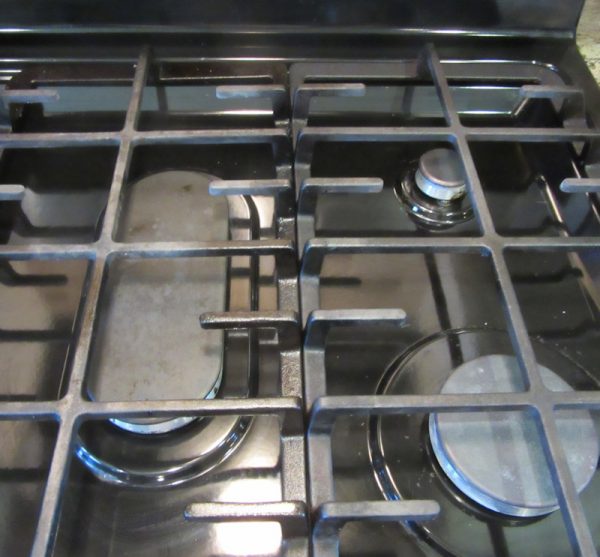If you google how to clean your stove grates with ammonia, you’ll come up with all kinds of suggestions. There’s at least one link in comments from yesterday.
Some recommend pouring a few tablespoons to a portion of a cup of ammonia over the grates and sealing them in zipper type bags.
The only way I’ve ever done it is to put my grates in a tub just large enough for the grates to sit flat, cover them with ammonia and let them sit at least 4 hours. I spent about $4 on ammonia but that was enough to clean three big grates that go front to back on my stove top.
By covering them with ammonia (and I’m not complaining about spending $4 because, as I confessed yesterday, it’s been 3 or 4 years since I really cleaned them), I didn’t have to do any real scrubbing. The gunk just peeled off.
Here’s step by step how I did it.
- Using an old cooler that was almost exactly the size as my grates (the cooler will become discolored from the grease, and probably ruined) I poured in enough ammonia to barely cover the grates.
- I submerged one grate completely and one-half of the middle narrower grate. I left that about 5 hours, took those out, put in the other larger grate and submerged the other half of the middle narrower grate.
- I did all this on my front porch.
- As I took them out, I carried them to the driveway (rocks – where I hope grass never grows again), used a medium stiff brush to brush away all the debris, squirted them off with the water hose. Done! Clean! Brand new looking.
Words of caution:
- Do this outside – in a place where children and pets will not be near it.
- Be very careful so you don’t take a breath while messing with the ammonia. I closed the lid to the cooler so as I opened it, I held my breath and stepped back to allow some of the escaping fumes to dissipate before retrieving the grates.
- If you have sensitive hands, you might want to wear gloves while doing this.
- Someone mentioned in a comment on the previous post about placing ammonia in the oven to loosen grease and gunk. Even though ammonia is not highly flammable, I’m not sure I would use it in a gas oven.
- Further, I am not sure I would do much with ammonia inside the house, unless it was highly diluted.
- I’m assuming that stove grates are cast iron and will hold up to being soaked in ammonia but don’t take my word for it. Check the composition of your grates before soaking them for hours in ammonia. I would hate for them to melt or become discolored in any way.
- Once your grates are clean, dispose of the used ammonia properly. Do not leave it where pets or animals might get too close. Most suggestions I read were either to dilute it (LOTS of water – some recommend 100:1 (water:ammonia) and flush it; some recommend bottling it and taking it to a location that is approved to accept that kind of waste. Since we’re on a septic tank and use well water, we will dispose of our used ammonia at a location that accepts this type waste. Using a funnel, I poured it back into the original bottles and will take it when our landfill has their special days for accepting paint, tires, chemicals, etc.
Ammonia is great for cleaning those nasty stove grates but be very careful with it and please be responsible with disposal.


debbierhodes says
I have done about the same with oven racks.. but put the ammonia in a big trash bag and set it outside laying flat… turned it over once…the racks were beautiful like new…no scrubbing..
Barbara says
I just clean mine in the dishwasher, works great
.